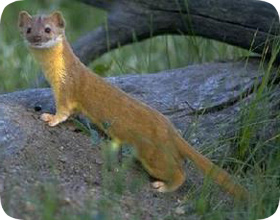- info@wildlife-removal.com
Call us for help in your town
Wildlife Removal Education
Weasel Removal and Control
Need weasel removal in your hometown? We service over 500 USA locations! Click here to hire us in your town and check prices - updated for year 2020.
 Weasels are usually classified as a pest species due to... The most common complaints include the following:
Weasels are usually classified as a pest species due to... The most common complaints include the following:
Need professional help? Click here for my Nationwide List of Weasel Trappers
Much of the information above also applies to Mink, which are very similar to weasels. Below are some Mink information and facts:
Minks are of the weasel family and can be categorized into two groups although there was the Sea Mink but their species have now been completely extinct. The species can now only be categorically grouped as the European Mink and the American Mink although you can almost decipher the difference between the two. The European mink is much smaller and usually has a large white patch on its upper lip unlike its counterpart.
This group of animals was previously bred for their fur which has been used for clothes and some other accessories. Their oil is also said to be a part of some medical products and may be a component of many cosmetics. In addition, their oil is used to preserve leather. Traditionally both categories were included in the same genus (Mustela) but now the American Mink was given due consideration and was given a different genus (Neovison). The American specie saw the decline of their European counterpart because they are less adaptable and aggressive.
Minks are also known to be good swimmers and can reach solitary islands or sanctuaries of birds. They are also said to be territorial animals and would defend their territories against their kin. Males and females are said to have different domiciles but males tend to be less aggressive when females sometimes overlap within their territory which occasionally do happen. A female normally has smaller habitats compared to their partners. Minks sometimes have a well-defined area where they spend most of their time. The inner area would of course be composed of their food source which may be a wide pond of fresh fish or maybe a rabbit warren.
Their dens may sometimes be found in boulders or in a tree trunks or roots or they may just be contented with a den of grass weeds or bracken. Those who can afford to climb on trees can also make use of nests left behind by birds and turn it into their own homes. There are might be some periods where males move from one territory to another because of several reasons and primarily would be to seek out their mate. They might also be forced to look for an alternative dwelling because of the scarcity of food source in their original territory. And there are the younger minks that are trying to live off on their own and thus seeking for a quite acceptable mode of dwelling.
Most of these creatures live a very solitary life and would try to tend to shy away from other animals even their own kind but due to the fact that they need to mate during some time in spring, they also try to seek out their mates. Females might just be a little sociable because they tend to be with other female minks like a cluster or a group and they also have their off springs to attend to and train for several months until these younger generations would be old enough to try to live on their own.
They also vary in sizes, a normal male can weigh as much as 1 kg (2.25 lbs.) or 7 lbs. for those who are bred in farms and reach a length of about 24 inches. Females on the other hand can weigh 600g or that would be equivalent to about 1.25 lbs. and can be as long as 20 inches. These measurements do not include their tails which can be an additional 5 to 9 inches. They are not expected to have longevity especially in the wild but if properly cared for especially for those who are kept as pets, they can last for several years.
Their diet also varies, a mink can eat anything small enough that it can catch on its own, meaning an easy prey or they can try to look for something bigger than themselves which they feel might be an edible feast as long as they can overcome it and eventually make a meal out of whatever animal it is.


















